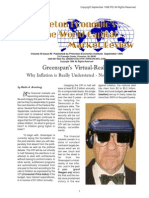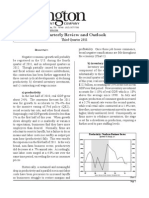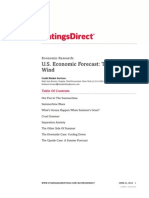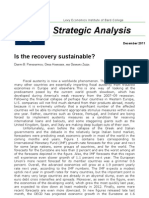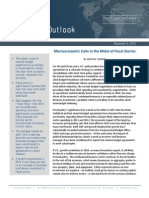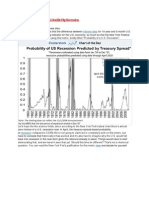0 ratings0% found this document useful (0 votes)
422 viewsGary Shilling Review and Forecast: Low Interest Rates
Gary Shilling Review and Forecast: Low Interest Rates
Uploaded by
richardck61The document provides a summary and forecast of the US economy by Gary Shilling. In 3 sentences:
Real GDP growth has averaged a slow 2.3% since the 2009 recovery due to continued private sector deleveraging, though optimists believe growth may pick up as fiscal drag lessens. Global growth also remains sluggish at around 3% according to the IMF forecast. Fiscal policy remains uncertain with gridlock in Washington and temporary measures set to expire, so further resolution of federal budget and debt issues is unclear.
Copyright:
Attribution Non-Commercial (BY-NC)
Available Formats
Download as PDF, TXT or read online from Scribd
Gary Shilling Review and Forecast: Low Interest Rates
Gary Shilling Review and Forecast: Low Interest Rates
Uploaded by
richardck610 ratings0% found this document useful (0 votes)
422 views22 pagesThe document provides a summary and forecast of the US economy by Gary Shilling. In 3 sentences:
Real GDP growth has averaged a slow 2.3% since the 2009 recovery due to continued private sector deleveraging, though optimists believe growth may pick up as fiscal drag lessens. Global growth also remains sluggish at around 3% according to the IMF forecast. Fiscal policy remains uncertain with gridlock in Washington and temporary measures set to expire, so further resolution of federal budget and debt issues is unclear.
Original Description:
Mauldin December 27
Original Title
Mauldin December 27
Copyright
© Attribution Non-Commercial (BY-NC)
Available Formats
PDF, TXT or read online from Scribd
Share this document
Did you find this document useful?
Is this content inappropriate?
The document provides a summary and forecast of the US economy by Gary Shilling. In 3 sentences:
Real GDP growth has averaged a slow 2.3% since the 2009 recovery due to continued private sector deleveraging, though optimists believe growth may pick up as fiscal drag lessens. Global growth also remains sluggish at around 3% according to the IMF forecast. Fiscal policy remains uncertain with gridlock in Washington and temporary measures set to expire, so further resolution of federal budget and debt issues is unclear.
Copyright:
Attribution Non-Commercial (BY-NC)
Available Formats
Download as PDF, TXT or read online from Scribd
Download as pdf or txt
0 ratings0% found this document useful (0 votes)
422 views22 pagesGary Shilling Review and Forecast: Low Interest Rates
Gary Shilling Review and Forecast: Low Interest Rates
Uploaded by
richardck61The document provides a summary and forecast of the US economy by Gary Shilling. In 3 sentences:
Real GDP growth has averaged a slow 2.3% since the 2009 recovery due to continued private sector deleveraging, though optimists believe growth may pick up as fiscal drag lessens. Global growth also remains sluggish at around 3% according to the IMF forecast. Fiscal policy remains uncertain with gridlock in Washington and temporary measures set to expire, so further resolution of federal budget and debt issues is unclear.
Copyright:
Attribution Non-Commercial (BY-NC)
Available Formats
Download as PDF, TXT or read online from Scribd
Download as pdf or txt
You are on page 1of 22
!"#$%"&' )*#+ &", -*#.&/0.
, ls a free weekly economlcs e-leLLer by besL-selllng auLhor and renowned flnanclal
experL !ohn Mauldln. ?ou can learn more and geL your free subscrlpLlon by vlslLlng www.mauldlneconomlcs.com
age 1
Gary Shilling: Review and Forecast
John Mauldin | December 27, 2013
Recovery Drivers
Global Slow Growth
Fiscal Drag
The Fed
Inflation-Deflation
Low Interest Rates
Speculation Returns
Housing
Capital Spending
Government Spending
U.S. Labor Markets
Part-Timers
Real Pay Falling
Consumer Spending
Shock?
Dubai, Saudi Arabia, Canada, and Auld Lang Syne
Should auld acquaintance be forgot
And never brought to mind?
Should auld acquaintance be forgot,
And auld lang syne!
For auld lang syne, my dear,
For auld lang syne,
We'll take a cup o' kindness yet
For auld lang syne
It's that time of year again, when we begin to think of what the next one will bring. I will be
doing my annual forecast issue next week, but my friend Gary Shilling has already done his and
has graciously allowed me to use a shortened version of his letter as this week's Thoughts from the
Frontline. So without any further ado, let's jump right to Gary's look at where we are and where
we're going.
Review and Forecast
By Gary Shilling
In the third quarter, real GDP grew 2.8% at annual rates from the second quarter. Without the
!"#$%"&' )*#+ &", -*#.&/0., ls a free weekly economlcs e-leLLer by besL-selllng auLhor and renowned flnanclal
experL !ohn Mauldln. ?ou can learn more and geL your free subscrlpLlon by vlslLlng www.mauldlneconomlcs.com
age 2
increase in inventories, the rate would be 2.0%, in line with the 2.3% average growth since the
economic recovery commenced in the second quarter of 2009.
Furthermore, the step-up in inventory-building from the second quarter may have been unintended,
suggesting cutbacks in production and weaker growth in future quarters. Also, consumer spending
growth, 1.5% in the third quarter, continues to slip from 1.8% in the second quarter and 2.3% in
the first while business spending on equipment and software actually fell at a 3.7% annual rate for
only the second time since the recovery started in mid-2009. Government spending was about flat
with gains in state and local outlays offsetting further declines in federal expenditures. Non-
residential outlays for structures showed strength as did residential building. The 16-day federal
government shutdown didn't commence until the start of the fourth quarter, October 1, but
anticipation may have affected the third quarter numbers.
Recovery Drivers
The 2.3% average real GDP growth in the recovery, for a total rise of 10%, has not only been an
extraordinarily slow one but also quite unusual in structure. Consumer spending has accounted for
65% of that growth, actually below its 68% of real GDP, as shown in the second column of Chart
1. Government spendingwhich in the GDP accounts is direct outlays for personal and goods and
services and doesn't include transfers like Social Security benefitshas actually declined. Federal
outlays fell 0.4% despite massive stimuli since most of it went to welfare and other transfers to
state governments. But state and local spending dropped 0.9% due to budget constraints.
!"#$%"&' )*#+ &", -*#.&/0., ls a free weekly economlcs e-leLLer by besL-selllng auLhor and renowned flnanclal
experL !ohn Mauldln. ?ou can learn more and geL your free subscrlpLlon by vlslLlng www.mauldlneconomlcs.com
age 3
Residential construction accounted for 9% of the gain in the economy. This exceeds its share of
GDP, but still is small since volatile housing normally leaps in recoveries, spurred by low interest
rates. But deterrents abound. The initial boost to the economy as retrenching consumers cut
imports was later reversed. So net exports reduced real GDP growth by 0.4% in the 13 quarters of
recovery to date.
Inventory-building accounted for a substantial 19% of the rise in real GDP, suggesting the
accumulation of undesired stocks since anticipation of future demand has been consistently
subdued. Nonresidential structures fell 0.1% as previous overbuilding left excess space. Equipment
!"#$%"&' )*#+ &", -*#.&/0., ls a free weekly economlcs e-leLLer by besL-selllng auLhor and renowned flnanclal
experL !ohn Mauldln. ?ou can learn more and geL your free subscrlpLlon by vlslLlng www.mauldlneconomlcs.com
age 4
spending contributed 20% of the overall growth, but has failed to shoulder the normal late
recovery burst.
Nevertheless, the small intellectual property products component, earlier called software,
accounted for 5% of overall growth compared to its 3.9% share of GDP. This reflects the
productivity-enhancing investments American business have been using to propel profit margins
and the bottom line in an era when sales volume has been weak and pricing power absent.
As we predicted over three years ago in our book The Age of Deleveraging: Investment strategies
for a decade of slow growth and deflation, and in many Insights since then, economic growth of
about 2% annually will probably persist until deleveraging, especially in the financial sector
globally and among U.S. consumers, is completed in another four or five years. Deleveraging after
a major leveraging binge and the financial crisis that inevitably follows normally takes around a
decade, and since the workdown of excess debt commenced in 2008, the process is now about half
over. The power of this private sector deleveraging is shown by the fact that even with the
immense fiscal stimuli earlier and ongoing massive monetary expansion, real growth has only
averaged 2.3% compared to 3.4% in the post-World War II era before the 2007-2009 Great
Recession.
Optimists, of course, continue to look for reasons why rapid growth is just around the corner, and
their latest ploy is the hope that the effects of individual income tax hikes and reduced federal
spending this year via sequestration have about run their course. Early this year when these
negative effects on spending were supposed to take place, scare-mongers in and out of Washington
predicted drastic negative effects on the economy. But federal bureaucrats apparently mitigated
much of the effects of sequestration, and the income tax increases on the rich, as usual, didn't
change their spending habits much. So the positive influences on the economy as sequestration
fades and income tax rates stabilize are likely to be equally minimal.
Furthermore, small-business sentiment has fallen recently. The percentage of companies that look
for economic improvement dropped from -2 in August to -10 in September and -17 in October to a
seven-month low. Those expecting higher sales declined from +8 to +2 in October. Most of the
other components of the index fell, including those related to the investment climate, hiring plans,
capital spending intentions, inventories, inflation expectations and plans to raise wages and prices.
Other recent measures of subdued economic activity include the New York Fed's survey of
manufacturing and business conditions and industrial production nationwide, which fell 0.1% in
October from September.
The New York Fed's Empire State manufacturing survey index for November fell to 2.21%, the
first negative reading since May. Every component droppedorders, shipments, inventories,
backlogs, employment, the workweek, vendor performance and inflation.
Global Slow Growth
The ongoing sluggish growth in the U.S. is indeed a global problem. It's true in the eurozone, the
U.K., Japan and China. Recently, the International Monetary Fund, in its sixth consecutive
downward revision, cut its global growth forecast for this year by 0.3 percentage points to 2.9%
!"#$%"&' )*#+ &", -*#.&/0., ls a free weekly economlcs e-leLLer by besL-selllng auLhor and renowned flnanclal
experL !ohn Mauldln. ?ou can learn more and geL your free subscrlpLlon by vlslLlng www.mauldlneconomlcs.com
age 3
and for 2014, by 0.2 percentage points to 3.6%.
It lowered its 2013 forecast for India from 5.6% to 3.8%, for Brazil from 3.2% to 2.5% and more
than halved Mexico's to 1.2%. For developing countries on average, the IMF reduced its 2013
growth forecast by 0.4 percentage points to 5%, citing the drying up of years of cheap liquidity,
competitive constraints, infrastructure shortfalls and slowing investment. It also worries about their
balance of payment woes. For 2014, the IMF chopped its growth forecast for China from 7.8% to
7.3% and from 2.8% to 2.6% for the U.S.
Fiscal Drag
Fed Chairman Bernanke continually worries about fiscal drag. Without question, the federal
budget was stimulative in earlier years when tax cuts and massive spending in reaction to the Great
Recession as well as weak corporate and individual tax collections pushed the annual deficit above
$1 trillion. But the unwinding of the extra spending, income tax increases and sequestration this
year and economic recoveryweak as it's beenhave reduced the deficit to $680 billion in fiscal
2013 that ended September 30.
From here on, the outlook is highly uncertain with persistent gridlock in Washington between
Democrats and Republicans. So far, they've kicked the federal budget and debt limit cans down the
road and they may do so again when temporary extensions expire early next year. It looks like
many in Congress have no intention of resolving these two problems and may be jockeying for
position ahead of the 2014, if not the 2016, elections.
In our many years of observing and talking to Congressmen, Senators and key Administration
officials of both parties, it's clear that Washington only acts when it has no alternative and faces
excruciating pressure. A collapsing stock market always gets their attention, but the ongoing
market rally, in effect, tells them that all is well or at least that it doesn't require immediate action.
The Fed
With muted economic growth and risks on the downside, distrust in the abilities or willingness of
Congress and the Administration to right the ship, and falling consumer and business confidence,
the burden of stimulating the economy remains with the Fed. Janet Yellen, the likely next
Chairman, seems even more committed than Bernanke to continuing to keep monetary policy
loose. The Fed plans to reduce its buying of $85 billion per month in securities but the negative
reactions by stocks (Chart 2), Treasury bonds (Chart 3) and many other securities to Bernanke's
hints in May and June that purchases would be tapered and eliminated by mid-2014 made a strong
impression on the Fed. Similarly, the release of the minutes of the Fed's October policy meeting
which again said officials looked forward to ending the bond-buying program "in coming months"
if conditions warrantedresulted in an instant drop in stock and bond prices.
!"#$%"&' )*#+ &", -*#.&/0., ls a free weekly economlcs e-leLLer by besL-selllng auLhor and renowned flnanclal
experL !ohn Mauldln. ?ou can learn more and geL your free subscrlpLlon by vlslLlng www.mauldlneconomlcs.com
age 6
!"#$%"&' )*#+ &", -*#.&/0., ls a free weekly economlcs e-leLLer by besL-selllng auLhor and renowned flnanclal
experL !ohn Mauldln. ?ou can learn more and geL your free subscrlpLlon by vlslLlng www.mauldlneconomlcs.com
age 7
The Fed is trying to figure out how to end security purchases without spiking interest rates, to the
detriment of housing, other U.S. economic sectors and developing economies. It's moving toward
"forward guidance," more commitment to keep the short-term interest rate it controls low than its
present pledge to keep it essentially at zero until the current 7.3% unemployment rate drops to
6.5% and its inflation rate measure climbs to 2.5% from the current 1.2% year-over-year.
The hope is that a longer-term commitment to keep short-term rates low will retard long rates as
well when the Fed tapers its asset purchases. This strategy appears to be having some success.
Treasury investors are switching from 10-year and longer issues to 2-year or shorter notes. This is
known as the yield-steepening trade as it pushes short-term yields down and longer yields up. As a
result, the spread between 2-year and 10-year Treasury obligations has widened to 2.54 percentage
points, the most since July 2011. Banks benefit from a steeper yield curve since they borrow short
term and lend in long-term markets. But borrowers pay more for loans linked to long-term
Treasury yields. There's a close link between the yield on 10-year Treasury notes and the 30-year
fixed rate on residential mortgages.
The Fed has already signaled that it may not wait to raise short rates until the unemployment rate, a
very unreliable gauge of job conditions as we've explained in past Insights, drops below 6.5%.
Bernanke recently said that "even after unemployment drops below 6.5%, the [Fed] can be patient
in seeking assurance that the labor market is sufficiently strong before considering any increase in
its target for the federal funds rate." At that point, the Fed will consider broader measures of the
job market including the labor participation rate. If the participation rate hadn't fallen from its
February 2000 peak due to postwar baby retirements, discouraged job-seekers and youths who
stayed in school since job opportunities dried up with the recession, the unemployment rate now
would be 13%.
The Fed is well aware that other than pushing up stock prices, its asset-buying program is having
little impact on the economy. In a recent speech, Bernanke said that while the Fed's commitment to
hold down interest rates and its asset purchases both are helping the economy, "we are somewhat
less certain about the magnitude of the effects on financial conditions and the economy of changes
in the pace of purchases or in the accumulated stock of assets on the Fed's balance sheet." We
wholeheartedly agree with this sentiment, as discussed in detail in our October Insight. Tapering
Fed monthly purchases only reduces the ongoing additions to already-massive excess member
bank reserves on deposit at the Fed.
Inflation-Deflation
Inflation has virtually disappeared. The Fed's favorite measure of overall consumer prices, the
Personal Consumption Expenditures Deflator excluding food and energy (Chart 4), is rising 1.2%
year-over-year, well below the central bank's 2.0% target and dangerously close to going negative.
!"#$%"&' )*#+ &", -*#.&/0., ls a free weekly economlcs e-leLLer by besL-selllng auLhor and renowned flnanclal
experL !ohn Mauldln. ?ou can learn more and geL your free subscrlpLlon by vlslLlng www.mauldlneconomlcs.com
age 8
There are many ongoing deflationary forces in the world, including falling commodity prices,
aging and declining populations globally, economic output well below potential, globalization of
production, growing worldwide protectionism including competitive devaluation in Japan,
declining real incomes, income polarization, declining union memberships, high unemployment
and downward pressure on federal and state and local government spending.
With the running out of 2009 federal stimulus money and gas tax revenues declining as fewer
miles are driven in more efficient cars, highway construction is declining and construction firms
are consolidating and reducing bids on new work even if their costs are rising. Highway
construction spending dropped 3.3% in the first eight months of 2013 compared to a year earlier.
Also, states are shifting scarce money away from transportation and to education and health care.
We've noted in past Insights that aggressive monetary and fiscal stimuli probably have delayed but
not prevented chronic deflation in producer and consumer prices.
Why does the Fed clearly fear deflation? Steadily declining prices can induce buyers to wait for
still-lower prices. So, excess capacity and inventories result and force prices lower. That confirms
suspicions and encourages buyers to wait even further. Those deflationary expectations are partly
responsible for the slow economic growth in Japan for two decades.
Low Interest Rates
With the Fed likely to continue to hold its federal funds rate close to zero, other short-term interest
!"#$%"&' )*#+ &", -*#.&/0., ls a free weekly economlcs e-leLLer by besL-selllng auLhor and renowned flnanclal
experL !ohn Mauldln. ?ou can learn more and geL your free subscrlpLlon by vlslLlng www.mauldlneconomlcs.com
age 9
rates will probably remain there too. So the recent rally in Treasury bonds may well continue, with
yields on the 10-year Treasury note, now 2.8%, dropping below 2% while the yield on our 32-year
favorite, the 30-year Treasury "long bond," falls from 3.9% to under 3%. Even-lower yields are in
store if chronic deflation sets in as well it might. Ditto for the rise in stocks, which we continue to
believe is driven predominantly by investor faith in the Fed, irrespective of modest economic
growth at best. "Don't fight the Fed," is the stock bulls' bellow. Supporting this enthusiasm has
been the rise in corporate profits, but that strength has been almost solely due to leaping profit
margins. Low economic growth has severely limited sales volume growth, and the absence of
inflation has virtually eliminated pricing power. So businesses have cut labor and other costs with
a vengeance as the route to bottom line growth
Wall Street analysts expect this margin leap to persist. In the third quarter, S&P 500 profit margins
at 9.6% were a record high but revenues rose only 2.7% from a year earlier. In the third quarter of
2014, they see S&P 500 net income jumping 14.9% from a year earlier on sales growth of only
4.7%. But profit margins have been flat at their peak level for seven quarters. And the risks appear
on the downside.
Productivity growth engendered by labor cost-cutting and other means is no longer easy to come
by, as it was in 2009 and 2010. Corporate spending on plant and equipment and other productivity-
enhancing investments has fallen 16% from a year ago. Also, neither capital nor labor gets the
upper hand indefinitely in a democracy, and compensation's share of national income has been
compressed as profit's share leaped. In addition, corporate earnings are vulnerable to the further
strengthening of the dollar, which reduces the value of exports and foreign earnings by U.S.
multinationals as foreign currency receipts are translated to greenbacks.
Speculation Returns
Driven by the zeal for yield due to low interest rates and the rise in stock prices that has elevated
the S&P 500 more than 160% from its March 2009 low, a degree of speculation has returned to
equities. The VIX index, a measure of expected volatility, remains at very low levels (Chart 5).
Individual investors are again putting money into U.S. equity mutual funds after years of
withdrawals. "Frontier" equity markets are in vogue. They're found in countries like Saudi Arabia,
Nigeria and Romania that have much less-developedand therefore riskyfinancial markets and
economies than Brazil and Mexico.
!"#$%"&' )*#+ &", -*#.&/0., ls a free weekly economlcs e-leLLer by besL-selllng auLhor and renowned flnanclal
experL !ohn Mauldln. ?ou can learn more and geL your free subscrlpLlon by vlslLlng www.mauldlneconomlcs.com
age 10
The IPO market has been hot this year. The median IPO has been priced at five times sales over
the last 12 months, almost back to the six times level of 2007. And many IPOs have used the
newly-raised funds to repay debt to their private equity backers, not to invest in business
expansion. Through early November, IPOs raised $51 billion, the most since the $62 billion in the
comparable period in 2000. Some 62% of IPOs this year are for money-losing companies, the most
since the 1999-2000 dot com bubble. Some hedge fund managers are introducing "long only"
funds with no hedges against potential stock price declines.
The S&P 500 index recently reached an all-time high but corrected for inflation, it remains in a
secular bear market that started in 2000. This reflects the slow economic growth since then and the
falling price-earnings ratio, and fits in with the long-term pattern of secular bull and bear markets,
as discussed in detail in our May 2013 Insight.
High P/E
Furthermore, from a long-term perspective, the P/E on the S&P 500 at 24.5 is 48% above its long
run average of 16.5 (Chart 6), and we're strong believers in reversions to well-established trends,
this one going back to 1881. The P/E developed by our friend and Nobel Prize winner, Robert
Shiller of Yale, averages earnings over the last 10 years to iron out cyclical fluctuations. Also,
since the P/E in the last two decades has been consistently above trend, it probably will be below
16.5 for a number of years to come.
!"#$%"&' )*#+ &", -*#.&/0., ls a free weekly economlcs e-leLLer by besL-selllng auLhor and renowned flnanclal
experL !ohn Mauldln. ?ou can learn more and geL your free subscrlpLlon by vlslLlng www.mauldlneconomlcs.com
age 11
This index is trading at 19 times its companies' earnings over the past 12 months, well above the
16 historic average. This year, about three-fourths of the rise in stock prices is due to the jump in
P/Es, not corporate earnings growth. Even always-optimistic Wall Street analysts don't expect this
P/E expansion to persist in light of possible Fed tightening. Those folks, of course, are paid to be
bullish and their track record proves it. Since 2000, stocks have returned 3.3% annually on
average, but strategists forecast 10%. They predicted stock rises in every year and missed all four
down years.
Housing
Residential construction is near and dear to the Fed's heart. It's a small sector but so volatile that it
has huge cyclical impact on the economy. At its height in the third quarter of 2005, it accounted
for 6.2% of GDP but fell to 2.5% in the third quarter of 2010 (Chart 7). That in itself constitutes a
recession, even without the related decline in appliances, home furnishings and autos.
!"#$%"&' )*#+ &", -*#.&/0., ls a free weekly economlcs e-leLLer by besL-selllng auLhor and renowned flnanclal
experL !ohn Mauldln. ?ou can learn more and geL your free subscrlpLlon by vlslLlng www.mauldlneconomlcs.com
age 12
Furthermore, the Fed can have a direct influence on housing. Monetary policy is a very blunt
instrument. The central bank only can lower interest rates and buy securities and then hope the
economy in general will be helped. In contrast, fiscal policy can aid the unemployed directly by
raising unemployment benefits. But by buying securities, especially mortgage-related issues, the
Fed can influence interest rates and help interest-sensitive housing. The rise in 30-year fixed
mortgage rates of over one percentage point last spring probably has brought the housing recovery
to at least a temporary halt. Each percentage point rate rise pushes up monthly principal and
interest payments by about 10%.
Of course, many other factors besides mortgage rates affect housing and have been restraining
influences. They include high downpayment requirements, stringent credit score levels,
employment status and job security and the reality that for the first time since the 1930s, house
prices have fallenby a third at their low.
Capital Spending
Many hope that record levels of corporate cash and low borrowing costs will propel capital
spending. And spending aimed at productivity enhancement, much of it on high-tech gear, has
been robust as business concentrates on cost-cutting, as noted earlier. But the bulk of plant and
equipment spending is driven by capacity utilization, and while it remains low, there's little zeal
for new outlays.
!"#$%"&' )*#+ &", -*#.&/0., ls a free weekly economlcs e-leLLer by besL-selllng auLhor and renowned flnanclal
experL !ohn Mauldln. ?ou can learn more and geL your free subscrlpLlon by vlslLlng www.mauldlneconomlcs.com
age 13
That's why capital spending lags the economic cycle. Only after the economy strengthens in
recoveries do utilization rates rise enough to spur surges in capital spending. And as our earlier
research revealed, it's the level of utilization, not the speed with which it's rising, that drives plant
and equipment outlays. So this is a Catch-22 situation. Until the economy accelerates and pushes
up utilization rates, capital spending will remain subdued. But what will cause that economic
growth spurt?
Government Spending
It's unlikely to be government spending. State and local outlays used to be a steady 12% or so of
GDP and a source of stable, well-paying jobs. But no more. State tax revenues are recovering
(Chart 8), but the federal stimulus money enacted in 2009 has dried up, leaving many states with
strained budgets.
Pressure also comes from private sector workers who are increasingly aware that while their pay
has been compressed by globalization and business cost-cutting, state and local employees have
gotten their usual 3% to 4% annual increases and lush benefits. As a result, those government
people have 45% higher pay than in the private sector, 33% more in wages and 73% in additional
benefits. Oversized retiree obligations have sunk cities in California and Rhode Island and pushed
Illinois to the brink of bankruptcy. Hopelessly-underfunded defined benefit pensions are a major
threat to state and local government finances.
Municipal government employment is down 3.3% from its earlier peak compared to -0.2% for
!"#$%"&' )*#+ &", -*#.&/0., ls a free weekly economlcs e-leLLer by besL-selllng auLhor and renowned flnanclal
experL !ohn Mauldln. ?ou can learn more and geL your free subscrlpLlon by vlslLlng www.mauldlneconomlcs.com
age 14
total payroll employment (Chart 9). And since these people are paid 1.45 times those in the private
sector, two job losses is the equivalent of three private sector job cuts in terms of income. Real
state and local outlays have fallen 9.5% since the third quarter of 2009.
Federal direct spending on goods and services, excluding Social Security, Medicare and other
transfers, has also been dropping, by 7.2% since the third quarter of 2010. Both defense and
nondefense real outlays are dropping, and this has occurred largely before the 2013 sequestration.
At the same time, federal government civilian employment, civilian and military, has dropped 6%
from its top (Chart 10).
!"#$%"&' )*#+ &", -*#.&/0., ls a free weekly economlcs e-leLLer by besL-selllng auLhor and renowned flnanclal
experL !ohn Mauldln. ?ou can learn more and geL your free subscrlpLlon by vlslLlng www.mauldlneconomlcs.com
age 13
U.S. Labor Markets
The U.S. labor market remains weak and of considerable concern to the Fed. Recent employment
statistics have been muddled by the government's 16-day shutdown in October and the impasse
over the debt ceiling. Initially, 850,000 employees were furloughed although the Pentagon recalled
most of its 350,000 civilian workers a week into the shutdown.
The unemployment rate has been falling, but because of the declining labor participation rate. We
explored this phenomenon in detail in "How Tight Are Labor Markets?" (June 2013 Insight). As
people age, their labor force participation rates tend to drop as they retire or otherwise leave the
workforce. With the aging postwar babies, those born between 1946 and 1964, this has resulted in
a downward trend in the overall participation ratebut it doesn't account for all of the decline.
The irony is that participation rates of younger people tend to be higher than for seniors, but are
declining. For 16-24-year-olds, the rate has declined sharply since 2000 as slow economic growth,
limited jobs and rising unemployment rates have encouraged these youths to stay in school or
otherwise avoid the labor force.
Meanwhile, the participation rates for those over 65 have climbed since the late 1990s as they are
forced to work longer than they planned. Many have been notoriously poor savers and were
devastated by the collapse in stocks in 2007-2009 after the 2000-2002 nosedive, two of only five
drops of more than 40% in the S&P 500 since 1900.
!"#$%"&' )*#+ &", -*#.&/0., ls a free weekly economlcs e-leLLer by besL-selllng auLhor and renowned flnanclal
experL !ohn Mauldln. ?ou can learn more and geL your free subscrlpLlon by vlslLlng www.mauldlneconomlcs.com
age 16
Part-Timers
An additional sign of job weakness is the large number of people who want to work full-time but
are only offered part-time positions"working part-time for economic reasons" is the Bureau of
Labor Statistics term (Chart 11)and these people total 8 million and constitute 5.6% of the
employed. This obviously reflects employer caution and the zeal to contain costs since part-timers
often don't have the pension and other benefits enjoyed by full-time employees.
This group will no doubt leap when Obamacare is fully implemented in 2015, according to its
current schedule. Employers with 50 or more workers have to offer healthcare insurance, but not to
those working less than 30 hours per week. When these people and those who have given up
looking for jobs are added to the headline unemployment rate, the result, the BLS's U-6
unemployment rate, leaped in the Great Recession and is still very high at 13.8% in October.
The weakness in the job market is amplified by the fact that most new jobs are in leisure and
hospitality, retailing, fast food and other low-paying industries, which accounted for a third of the
204,000 new jobs in October. Manufacturing, which pays much more, has added some employees
as activity rebounds but growth has been modest.
Real Pay Falling
With all the downward pressure on labor markets, real weekly wages are falling on balance. The
!"#$%"&' )*#+ &", -*#.&/0., ls a free weekly economlcs e-leLLer by besL-selllng auLhor and renowned flnanclal
experL !ohn Mauldln. ?ou can learn more and geL your free subscrlpLlon by vlslLlng www.mauldlneconomlcs.com
age 17
folks on top of the income pile have recovered all their Great Recession setbacks and then some,
on average. The rest, perhaps three-fourths of the population, believe they areand probably still
aremired in recession due to declining real wages, still-depressed house prices, etc.
Consequently, the share of total income by the top one-fifth, which has been rising since the data
started in 1967, has jumped in recent years. The remaining four quintile shares continue to fall,
although falling shares do not necessarily mean falling incomes.
The average household in the top 20% by income has seen that income rise 6% since 2008 in real
terms and the top 5% of earners had an 8% jump. The middle quintile gained just 2% while the
bottom 29% are still below their pre-recession peak. A study of household incomes over the 2002-
2012 decade shows that the top 0.01% gained 76.2% in real terms but the bottom 90% lost 10.7%.
In 2012, the top 1% by income got 19.3% of the total. The only year when their share was bigger
was 1928 at 19.6%.
Real median household income, that of the household in the middle of the spectrum, continues to
drop on balance, only leveling last year from 2011 (Chart 12). In 2012, it was down 8.3% from the
prerecession 2007 level and off 9.1% from the 1999 all-time top. Americans may accept a
declining share of income as long as their spending power is increasing, but that's no longer true, a
reality that President Obama plays to with his "fat cat bankers" and other remarks.
Households earning $50,000 or more have become increasingly more confident, according to a
monthly survey by RBC Capital Markets, but confidence among lower-income households
!"#$%"&' )*#+ &", -*#.&/0., ls a free weekly economlcs e-leLLer by besL-selllng auLhor and renowned flnanclal
experL !ohn Mauldln. ?ou can learn more and geL your free subscrlpLlon by vlslLlng www.mauldlneconomlcs.com
age 18
stagnated, created a near-record gap between the two. Of the 2.3 million jobs added in the past
year, 35% were in jobs paying, on average, below $20 per hour in industries such as retailing and
leisure and hospitality. Since the recession ended, hourly wages for non-managers in the lowest-
paying quarter of industries are up 6% but more than 12% in the top-paying quarter. These income
disparities are reflected in consumer spending. In the first nine months of this year, sales of luxury
cars were up 12% from a year earlier but small-car sales rose just 6.1%.
Consumer Spending
With housing, capital spending, government outlays and net exports unlikely to promote rapid
economic growth in coming quarters, the only possible sparkplug is the consumer. Consumer
outlays account for 69% of GDP, and with falling real wages and incomes, the only way for real
consumer spending to rise is for their already-low saving rate to fall further.
Even the real wealth effect, the spur to spending due to rises in net worth, is now muted. In the
past, it's estimated that each $1 rise in equity value boosted consumer spending by three cents over
the following 18 months while a dollar more in house value led to eight cents more in outlays. But
now the numbers are two cents and five cents, respectively.
True, the ratio of monthly financing payments to their after-tax income has been falling for
homeowners, freeing money for spending. Those obligations include monthly mortgage, credit
card and auto loan and lease payments as well as property taxes and homeowner insurance.
Nevertheless, for the third of households that rent, their average financial obligations ratio has
been rising in the last two years as rents rise while vacancies drop.
Declining gasoline prices have given consumers extra money for other purchases, and are probably
behind the recent rise in gas-guzzling pickup truck and SUV sales. Furthermore, the automatic
Social Security benefit cost-of-living escalator will increase benefits by 1.5% in 2014 for 63
million recipients of retirement and disability payments. Still, with low inflation in 2013, the
basing year, that increase is smaller than the 1.7% rise last year and the lowest since 2003,
excluding 2010 and 2011 when there were no increases due to a lack of inflation. Social Security
retirement checks will rise $19 per month to $1,294, on average, starting in January.
In any event, retail sales growth is running about 4% at annual rates recently, about half the earlier
recovery strength (Chart 13). And a lot of this growth has been spurred by robust auto sales,
allegedly driven by the need to replace aged vehicles.
!"#$%"&' )*#+ &", -*#.&/0., ls a free weekly economlcs e-leLLer by besL-selllng auLhor and renowned flnanclal
experL !ohn Mauldln. ?ou can learn more and geL your free subscrlpLlon by vlslLlng www.mauldlneconomlcs.com
age 19
Shock?
Insight readers know we've been waiting for a shock to remind equity investors of the fundamental
weakness of the economy, and perhaps push the sluggish economy into a recession. With
underlying real growth of only 2%, it won't take much of a setback to do the job.
Will the negative effects of the government shutdown and debt ceiling standoff, coupled with the
confusion caused by the rollout of Obamacare, be a sufficient shock? The initial Christmas retail
selling season may tell the tale, and the risks are on the down side. Besides the consumer, we're
focused on corporate profits, which may not hold up in the face of persistently slow sales growth,
no pricing power and increasing difficulty in raising profit margins.
Nevertheless, we are not forecasting a recession for now, but rather more of the same, dull, slack
2% real GDP growth as in the four-plus years of recovery to date.
If you like what you read and would like to keep up with Gary for the next year, you can
subscribe to Gary Shilling's Insight for one year for $335 via email. Along with 12 months
of Insight you'll also receive a free copy of his full report detailing why he believes it will
be "advantage America" in the coming years and a free copy of Gary's latest book, Letting
Off More Steam. To subscribe, call 1-888-346-7444 or 973-467-0070 between 10 am and 4
pm Eastern time or email insight@agaryshilling.com. Be sure to mention Thoughts from
the Frontline to get the special report and free book in addition to your 12 months of
!"#$%"&' )*#+ &", -*#.&/0., ls a free weekly economlcs e-leLLer by besL-selllng auLhor and renowned flnanclal
experL !ohn Mauldln. ?ou can learn more and geL your free subscrlpLlon by vlslLlng www.mauldlneconomlcs.com
age 20
Insight (available only to new subscribers).
Dubai, Saudi Arabia, Canada, and Auld Lang Syne
(For a little mood music, you can listen to James Taylor croon "Auld Lang Syne." Or
here's the Beach Boys version.)
I am home for the holidays until January 8, when I leave for Dubai and then Riyadh for a
week. There is the potential for a day trip to Abu Dhabi to meet with Maine fishing buddy Paul
O'Brien. Then I am back home for a week before I fly to Vancouver, Edmonton, and Regina for a
three-day speaking tour at those cities' respective annual CFA forecast dinners. A note from a
reader in Edmonton pointed out that it is already -30 there. I am actively hunting for my thermal
underwear.
Oddly enough, my calendar then shows me home for four weeks before I head to Laguna
Beach, CA, for a speech and then hop a plane to Miami. You would think that someone who flies
as much as I do would have done a cross-country flight more than a few times, but this will be my
first time ever to fly coast to coast in the US.
As noted last week, all my kids will be in town tonight, and we will celebrate our "official"
family Christmas tomorrow. The poor grandchildren have had to wait three extra days to open
their presents, but I keep telling them that waiting builds character. I get looks back from them that
say they're not sure what character is but they want nothing to do with it.
I have always enjoyed this time of year as an interlude for contemplating the future. For
whatever reason, since I was in college I have paused as the new year approached to think about
where I wanted to be in five years. Given that I'm 64, that means I've gone through this process
some 42 times and seen the completion of 37 five-year planning cycles.
My batting average to date is 0 for 37. I never end up where I thought I was going to be,
although there are times when I at least get the direction right, and fortunately there even a few
times when the new midcourse correction means things turn out even better than planned.
Next week I write my 2014 forecast, for which the theme will be "Uncertainty." Yet even
in the face of overwhelming uncertainty, I will still come up with a personal five-year plan. Given
the rather unique set of opportunities that have been presented to me in the past year, the plan is
rather ambitious. And I expect it to change a lot. Among other projects, I expect to be announcing
several new letters in the coming months that will be specifically directed to strategic portfolio
planning. Right now our plan is to make these letters more or less freely available.
But the one thing that will hopefully not change is that I will be writing this letter to you, as
together we try to make sense of the world. As the year draws to a close, I want to thank you for
being part of my family of readers. And may the coming year surpass all your most wildly
optimistic plans.
!"#$%"&' )*#+ &", -*#.&/0., ls a free weekly economlcs e-leLLer by besL-selllng auLhor and renowned flnanclal
experL !ohn Mauldln. ?ou can learn more and geL your free subscrlpLlon by vlslLlng www.mauldlneconomlcs.com
age 21
Your hearing "Auld Lang Syne" analyst,
John Mauldin
Share Your Thoughts on This Article
Send Lo a lrlend | rlnL ArLlcle | vlew as ul | ermlsslons/8eprlnLs | revlous ArLlcle
Thoughts From the Frontline is a free weekly economic e-letter by best-selling author and renowned financial expert,
John Mauldin. You can learn more and get your free subscription by visiting http://www.mauldineconomics.com.
Please write to subscribers@mauldineconomics.com to inform us of any reproductions, including when and where
copy will be reproduced. You must keep the letter intact, from introduction to disclaimers. If you would like to quote
brief portions only, please reference http://www.mauldineconomics.com.
To subscribe to John Mauldin's e-letter, please click here: http://www.mauldineconomics.com/subscribe/
To change your email address, please click here: http://www.mauldineconomics.com/change-address
If you would ALSO like changes applied to the Mauldin Circle e-letter, please include your old and new email address
along with a note requesting the change for both e-letters and send your request to compliance@2000wave.com.
To unsubscribe, please refer to the bottom of the email.
Thoughts From the Frontline and JohnMauldin.com is not an offering for any investment. It represents only the
opinions of John Mauldin and those that he interviews. Any views expressed are provided for information purposes
only and should not be construed in any way as an offer, an endorsement, or inducement to invest and is not in any
way a testimony of, or associated with, Mauldin's other firms. John Mauldin is the Chairman of Mauldin Economics,
LLC. He also is the President of Millennium Wave Advisors, LLC (MWA) which is an investment advisory firm
registered with multiple states, President and registered representative of Millennium Wave Securities, LLC, (MWS)
member FINRA, SIPC. MWS is also a Commodity Pool Operator (CPO) and a Commodity Trading Advisor (CTA)
registered with the CFTC, as well as an Introducing Broker (IB) and NFA Member. Millennium Wave Investments is a
dba of MWA LLC and MWS LLC. This message may contain information that is confidential or privileged and is
intended only for the individual or entity named above and does not constitute an offer for or advice about any
alternative investment product. Such advice can only be made when accompanied by a prospectus or similar offering
document. Past performance is not indicative of future performance. Please make sure to review important
disclosures at the end of each article. Mauldin companies may have a marketing relationship with products and
services mentioned in this letter for a fee.
Note: Joining the Mauldin Circle is not an offering for any investment. It represents only the opinions of John Mauldin
and Millennium Wave Investments. It is intended solely for investors who have registered with Millennium Wave
!"#$%"&' )*#+ &", -*#.&/0., ls a free weekly economlcs e-leLLer by besL-selllng auLhor and renowned flnanclal
experL !ohn Mauldln. ?ou can learn more and geL your free subscrlpLlon by vlslLlng www.mauldlneconomlcs.com
age 22
Investments and its partners at www.MauldinCircle.com or directly related websites. The Mauldin Circle may send out
material that is provided on a confidential basis, and subscribers to the Mauldin Circle are not to send this letter to
anyone other than their professional investment counselors. Investors should discuss any investment with their
personal investment counsel. John Mauldin is the President of Millennium Wave Advisors, LLC (MWA), which is an
investment advisory firm registered with multiple states. John Mauldin is a registered representative of Millennium
Wave Securities, LLC, (MWS), an FINRA registered broker-dealer. MWS is also a Commodity Pool Operator (CPO)
and a Commodity Trading Advisor (CTA) registered with the CFTC, as well as an Introducing Broker (IB). Millennium
Wave Investments is a dba of MWA LLC and MWS LLC. Millennium Wave Investments cooperates in the consulting
on and marketing of private and non-private investment offerings with other independent firms such as Altegris
Investments; Capital Management Group; Absolute Return Partners, LLP; Fynn Capital; Nicola Wealth Management;
and Plexus Asset Management. Investment offerings recommended by Mauldin may pay a portion of their fees to
these independent firms, who will share 1/3 of those fees with MWS and thus with Mauldin. Any views expressed
herein are provided for information purposes only and should not be construed in any way as an offer, an
endorsement, or inducement to invest with any CTA, fund, or program mentioned here or elsewhere. Before seeking
any advisor's services or making an investment in a fund, investors must read and examine thoroughly the respective
disclosure document or offering memorandum. Since these firms and Mauldin receive fees from the funds they
recommend/market, they only recommend/market products with which they have been able to negotiate fee
arrangements.
PAST RESULTS ARE NOT INDICATIVE OF FUTURE RESULTS. THERE IS RISK OF LOSS AS WELL AS THE
OPPORTUNITY FOR GAIN WHEN INVESTING IN MANAGED FUNDS. WHEN CONSIDERING ALTERNATIVE
INVESTMENTS, INCLUDING HEDGE FUNDS, YOU SHOULD CONSIDER VARIOUS RISKS INCLUDING THE
FACT THAT SOME PRODUCTS: OFTEN ENGAGE IN LEVERAGING AND OTHER SPECULATIVE INVESTMENT
PRACTICES THAT MAY INCREASE THE RISK OF INVESTMENT LOSS, CAN BE ILLIQUID, ARE NOT REQUIRED
TO PROVIDE PERIODIC PRICING OR VALUATION INFORMATION TO INVESTORS, MAY INVOLVE COMPLEX
TAX STRUCTURES AND DELAYS IN DISTRIBUTING IMPORTANT TAX INFORMATION, ARE NOT SUBJECT TO
THE SAME REGULATORY REQUIREMENTS AS MUTUAL FUNDS, OFTEN CHARGE HIGH FEES, AND IN MANY
CASES THE UNDERLYING INVESTMENTS ARE NOT TRANSPARENT AND ARE KNOWN ONLY TO THE
INVESTMENT MANAGER. Alternative investment performance can be volatile. An investor could lose all or a
substantial amount of his or her investment. Often, alternative investment fund and account managers have total
trading authority over their funds or accounts; the use of a single advisor applying generally similar trading programs
could mean lack of diversification and, consequently, higher risk. There is often no secondary market for an investor's
interest in alternative investments, and none is expected to develop.
All material presented herein is believed to be reliable but we cannot attest to its accuracy. Opinions expressed in
these reports may change without prior notice. John Mauldin and/or the staffs may or may not have investments in
any funds cited above as well as economic interest. John Mauldin can be reached at 800-829-7273.
You might also like
- SAP US Payroll Tax - Well ExplainedDocument45 pagesSAP US Payroll Tax - Well ExplainedSuren Reddy69% (16)
- 5 Reasons To Fear A US Double DipDocument5 pages5 Reasons To Fear A US Double DipbenclaremonNo ratings yet
- 09.07.12 JPM Fiscal Cliff White PaperDocument16 pages09.07.12 JPM Fiscal Cliff White PaperRishi ShahNo ratings yet
- What Is GDP?: Kimberly AmadeoDocument44 pagesWhat Is GDP?: Kimberly Amadeobhupenderkamra100% (1)
- 1996 Issue # 9Document26 pages1996 Issue # 9Hugo JamesNo ratings yet
- Global 4Document89 pagesGlobal 4MiltonThitswaloNo ratings yet
- Van Hoisington Letter, Q3 2011Document5 pagesVan Hoisington Letter, Q3 2011Elliott WaveNo ratings yet
- Monthly Economic Outlook 06082011Document6 pagesMonthly Economic Outlook 06082011jws_listNo ratings yet
- 11 07 2012 EOTM Post Election ThoughtsDocument5 pages11 07 2012 EOTM Post Election ThoughtsForbesNo ratings yet
- Wien Byron - August 2010 Market CommentaryDocument3 pagesWien Byron - August 2010 Market CommentaryZerohedgeNo ratings yet
- Quarterly Review and Outlook: High Debt Leads To RecessionDocument5 pagesQuarterly Review and Outlook: High Debt Leads To RecessiongregoryalexNo ratings yet
- Weekly Economic Commentary 7-19-2012Document7 pagesWeekly Economic Commentary 7-19-2012monarchadvisorygroupNo ratings yet
- Weekly Economic Commentary 8/26/2013Document5 pagesWeekly Economic Commentary 8/26/2013monarchadvisorygroupNo ratings yet
- ProQuestDocuments 2016-11-06Document8 pagesProQuestDocuments 2016-11-06JohnWillis22No ratings yet
- The Great American Non-RecoveryDocument10 pagesThe Great American Non-Recoverystreettalk700No ratings yet
- The Economy and Housing Continue To Tread Water: Two-Year Yields On Greek Debt SurgeDocument6 pagesThe Economy and Housing Continue To Tread Water: Two-Year Yields On Greek Debt SurgeRossy JonesNo ratings yet
- Cutting To The CoreDocument2 pagesCutting To The CoreSamuel RinesNo ratings yet
- HIM2016Q1NPDocument9 pagesHIM2016Q1NPlovehonor0519No ratings yet
- U.S. Economic Forecast: Gale WarningDocument9 pagesU.S. Economic Forecast: Gale Warningapi-227433089No ratings yet
- 5 6 Special Topics in FINMGT PDFDocument11 pages5 6 Special Topics in FINMGT PDFramon olpotNo ratings yet
- 2017-08 Some Speed Bumps Slowing The BullDocument4 pages2017-08 Some Speed Bumps Slowing The BullMichael BenzingerNo ratings yet
- Jul 16 Erste Group Macro Markets UsaDocument6 pagesJul 16 Erste Group Macro Markets UsaMiir ViirNo ratings yet
- Eco ReadingsDocument3 pagesEco ReadingsnoviceNo ratings yet
- U.S. Economic Forecast: The Summer WindDocument13 pagesU.S. Economic Forecast: The Summer Windapi-227433089No ratings yet
- The New Normal of Healthcare SpendingDocument17 pagesThe New Normal of Healthcare Spendingrichardck61No ratings yet
- Destablizing An Unstable EconomyDocument20 pagesDestablizing An Unstable EconomyfahdaliNo ratings yet
- Byron Wien: Investment Outlook 3-3-2014Document4 pagesByron Wien: Investment Outlook 3-3-2014dpbasicNo ratings yet
- Slow Growth and Making America Great AgainDocument51 pagesSlow Growth and Making America Great AgainFinancial SenseNo ratings yet
- A. Gary Shilling's: InsightDocument4 pagesA. Gary Shilling's: Insightstreettalk700100% (1)
- Factors influencing business decisionsDocument5 pagesFactors influencing business decisionsaiman.aimanfatima08No ratings yet
- Spring 2014 Optimal Bundle: Issue XIIIDocument2 pagesSpring 2014 Optimal Bundle: Issue XIIIColennonNo ratings yet
- Levy Economics Institute of Bard College Strategic Analysis December 2011 Is The Recovery Sustainable?Document20 pagesLevy Economics Institute of Bard College Strategic Analysis December 2011 Is The Recovery Sustainable?mrwonkishNo ratings yet
- Economy Is On The Brink-Unless We Change Our Spending Habits The Economy Will CollapseDocument2 pagesEconomy Is On The Brink-Unless We Change Our Spending Habits The Economy Will Collapsepritpal40No ratings yet
- Karachi:: GDP Growth DefinitionDocument4 pagesKarachi:: GDP Growth DefinitionVicky AullakhNo ratings yet
- Global Weekly Economic Update - Deloitte InsightsDocument34 pagesGlobal Weekly Economic Update - Deloitte InsightsGANGULYABHILASHANo ratings yet
- Uline Presentation: Bill BroydrickDocument31 pagesUline Presentation: Bill BroydrickAwsaf Amanat Khan AuzzieNo ratings yet
- Mauldin October 22Document12 pagesMauldin October 22richardck61No ratings yet
- Federal Reserve Bank of San FranciscoDocument7 pagesFederal Reserve Bank of San FranciscoMargaret CanfieldNo ratings yet
- Where Cut TaxesDocument6 pagesWhere Cut TaxesMike SauterNo ratings yet
- Lutho QobaDocument8 pagesLutho QobaLutho Soso001No ratings yet
- The Pensford Letter - 10.1.12Document4 pagesThe Pensford Letter - 10.1.12Pensford FinancialNo ratings yet
- Outlook 2012 - Raymond JamesDocument2 pagesOutlook 2012 - Raymond JamesbubbleuppNo ratings yet
- A Bubble in ComplacencyDocument10 pagesA Bubble in Complacencyrichardck61No ratings yet
- RbsjanuaryDocument1 pageRbsjanuaryapi-120795630No ratings yet
- Staloscapital Macroeconomicscenario2012 111222051601 Phpapp02Document16 pagesStaloscapital Macroeconomicscenario2012 111222051601 Phpapp02stockboxNo ratings yet
- Koo Read+ +dec+14+2010+ +Roller+Coaster+Ride+for+Bond+MarketDocument10 pagesKoo Read+ +dec+14+2010+ +Roller+Coaster+Ride+for+Bond+Marketavicohen85No ratings yet
- Hat To Xpect In: HE Conomy at A LanceDocument2 pagesHat To Xpect In: HE Conomy at A LancetheowlfundNo ratings yet
- Fiscal Policy Nov 2013 FINALDocument7 pagesFiscal Policy Nov 2013 FINALkunalwarwickNo ratings yet
- Chart: Zero Chance of A U.S. Double Dip Recession: Business InsiderDocument9 pagesChart: Zero Chance of A U.S. Double Dip Recession: Business InsiderChirag AbrolNo ratings yet
- Market Week-June 4, 2012Document2 pagesMarket Week-June 4, 2012Janet BarrNo ratings yet
- Good News Is Bad News Once Again As Stronger Employment Growth Spooks MarketsDocument12 pagesGood News Is Bad News Once Again As Stronger Employment Growth Spooks Marketsjjy1234No ratings yet
- Weekly Economic Commentary 01-30-12Document4 pagesWeekly Economic Commentary 01-30-12monarchadvisorygroupNo ratings yet
- America's Albatross of Debt by David Stockman (4/4)Document7 pagesAmerica's Albatross of Debt by David Stockman (4/4)Tom SenbergNo ratings yet
- Economic and Market: A U.S. Recession?Document16 pagesEconomic and Market: A U.S. Recession?dpbasicNo ratings yet
- Yellen Speech 7.10Document15 pagesYellen Speech 7.10ZerohedgeNo ratings yet
- The Outlook For Recovery in The U.S. EconomyDocument13 pagesThe Outlook For Recovery in The U.S. EconomyZerohedgeNo ratings yet
- Revenue Status Report FY 2011-2012 - General Fund 20111031Document19 pagesRevenue Status Report FY 2011-2012 - General Fund 20111031Infosys GriffinNo ratings yet
- May 2013 Financial UpdateDocument6 pagesMay 2013 Financial UpdateAlfonso RobinsonNo ratings yet
- Weekly Economic Commentary 5/13/2013Document5 pagesWeekly Economic Commentary 5/13/2013monarchadvisorygroupNo ratings yet
- Kimberly - Economics Internal AssesmentDocument8 pagesKimberly - Economics Internal Assesmentkimberly.weynata.4055No ratings yet
- Friedberg 3Q ReportDocument16 pagesFriedberg 3Q Reportrichardck61No ratings yet
- Mauldin October 12Document5 pagesMauldin October 12richardck61No ratings yet
- Keynote SacksDocument7 pagesKeynote Sacksrichardck61No ratings yet
- Degussa Marktreport Engl 22-07-2016Document11 pagesDegussa Marktreport Engl 22-07-2016richardck61No ratings yet
- Six Ways NIRP Is Economically NegativeDocument14 pagesSix Ways NIRP Is Economically Negativerichardck61No ratings yet
- Report From Abu Dhabi ... and DallasDocument13 pagesReport From Abu Dhabi ... and Dallasrichardck61No ratings yet
- ODT Note 1 Unloved TreasuriesDocument2 pagesODT Note 1 Unloved Treasuriesrichardck61No ratings yet
- Mauldin June 4Document15 pagesMauldin June 4richardck61No ratings yet
- TrumpedDocument12 pagesTrumpedrichardck61No ratings yet
- Mauldin May 9Document18 pagesMauldin May 9richardck61No ratings yet
- An Open Letter To The Next President: Newport Beach, New York, and An SIC Conference UpdateDocument16 pagesAn Open Letter To The Next President: Newport Beach, New York, and An SIC Conference Updaterichardck61No ratings yet
- Growth Is The Answer To EverythingDocument11 pagesGrowth Is The Answer To Everythingrichardck61No ratings yet
- GoldMoney Insights Feb 2016 Buffets Math Trumped by GoldDocument9 pagesGoldMoney Insights Feb 2016 Buffets Math Trumped by Goldrichardck61No ratings yet
- ZIRP & NIRP: Killing Retirement As We Know ItDocument15 pagesZIRP & NIRP: Killing Retirement As We Know Itrichardck61No ratings yet
- The Federal Reserve and Sound Money: National Center For Policy AnalysisDocument4 pagesThe Federal Reserve and Sound Money: National Center For Policy Analysisrichardck61No ratings yet
- Global Macro Commentary March 15 - BamboozledDocument3 pagesGlobal Macro Commentary March 15 - Bamboozledrichardck61No ratings yet
- Results and DiscussionDocument7 pagesResults and DiscussionTamara AllejeNo ratings yet
- Termination GuidelinesDocument21 pagesTermination GuidelinesGustafaGovachefMotivatiNo ratings yet
- Tech Process Senior Assoicate - Cloud Activation - GammaDocument2 pagesTech Process Senior Assoicate - Cloud Activation - GammaPooja JainNo ratings yet
- SITXHRM008 Student Assessment Tasks. Chanpreet SinghDocument45 pagesSITXHRM008 Student Assessment Tasks. Chanpreet Singhpreet.australia239No ratings yet
- Costco Factory Audit Document List (Checklist)Document2 pagesCostco Factory Audit Document List (Checklist)Federico Villagran100% (1)
- Ajol File Journals - 463 - Articles - 151750 - Submission - Proof - 151750 5461 398082 1 10 20170217Document22 pagesAjol File Journals - 463 - Articles - 151750 - Submission - Proof - 151750 5461 398082 1 10 20170217lucìaNo ratings yet
- Users of Accounting InformationDocument17 pagesUsers of Accounting InformationZybel Rosales67% (3)
- Doing Business Guide Uae FinalDocument22 pagesDoing Business Guide Uae FinalSUHAIL AHAMED100% (1)
- SwatiPrashar - CV - HR OfficerDocument3 pagesSwatiPrashar - CV - HR OfficerClash ClashhNo ratings yet
- Business Ethics Q2 Mod2 4 The Business Responsibilities and Accountabilities v3 1Document45 pagesBusiness Ethics Q2 Mod2 4 The Business Responsibilities and Accountabilities v3 1johnchristopherperez08No ratings yet
- Urban Infrastructure PPPDocument98 pagesUrban Infrastructure PPPvandytvNo ratings yet
- Mitsubishi Motors Vs Chrysler Philippines Labor UnionDocument2 pagesMitsubishi Motors Vs Chrysler Philippines Labor UnionKobe BullmastiffNo ratings yet
- KDIOG CorporateDocument12 pagesKDIOG CorporateifiokdomNo ratings yet
- 2007-2026 Romania National Tourism Master Plan 2007-2026 PDFDocument154 pages2007-2026 Romania National Tourism Master Plan 2007-2026 PDFmanagement_seminarNo ratings yet
- Transcript From The Interview of Atty. Placido R. Alcomendras IiiDocument3 pagesTranscript From The Interview of Atty. Placido R. Alcomendras IiiAure ReidNo ratings yet
- Report On Beximco Pharma: Course: Training and Development - Course Code: HRM 340 Section: 3 Team: Cross TrainerDocument25 pagesReport On Beximco Pharma: Course: Training and Development - Course Code: HRM 340 Section: 3 Team: Cross TrainerValakNo ratings yet
- Agreement For Compromise Between The Employer Andworkman For Payment of Compensation Under Workmen - S Compensation ActDocument2 pagesAgreement For Compromise Between The Employer Andworkman For Payment of Compensation Under Workmen - S Compensation ActP SHIVA KUMAR MUDALIARNo ratings yet
- CocaCola v. Montinola DigestDocument3 pagesCocaCola v. Montinola DigestWilliam AzucenaNo ratings yet
- Service Agreement - Michael Gerrard ObejeraDocument4 pagesService Agreement - Michael Gerrard ObejeraMary Dee RozalNo ratings yet
- RETRENCHMENT Labour NotesDocument16 pagesRETRENCHMENT Labour NotesNew NormalNo ratings yet
- Assessment of Reward Management Practice and Its Effects On The EmployeesDocument75 pagesAssessment of Reward Management Practice and Its Effects On The Employeeschiro67% (3)
- Bernarte Vs PBADocument1 pageBernarte Vs PBASheryl OgocNo ratings yet
- Operation ManagementDocument13 pagesOperation ManagementWint Yee khaingNo ratings yet
- U.S. HHS Budget For Administration For Children and Families FY 2012Document400 pagesU.S. HHS Budget For Administration For Children and Families FY 2012Beverly TranNo ratings yet
- Organising and StaffingDocument18 pagesOrganising and StaffingJith EGNo ratings yet
- T. K. Group of IndustriesDocument11 pagesT. K. Group of IndustriesSk. Shahriar RahmanNo ratings yet
- 5.topic 3 - HR Planning, Job Analysis & DesignDocument45 pages5.topic 3 - HR Planning, Job Analysis & DesignA Ahmad NazreenNo ratings yet
- Shweta Khandelwal CVDocument3 pagesShweta Khandelwal CVAkash MatwaniNo ratings yet
- Sure Short Questions Business Studies Class-Xii (Commerce)Document35 pagesSure Short Questions Business Studies Class-Xii (Commerce)JaspreetNo ratings yet




